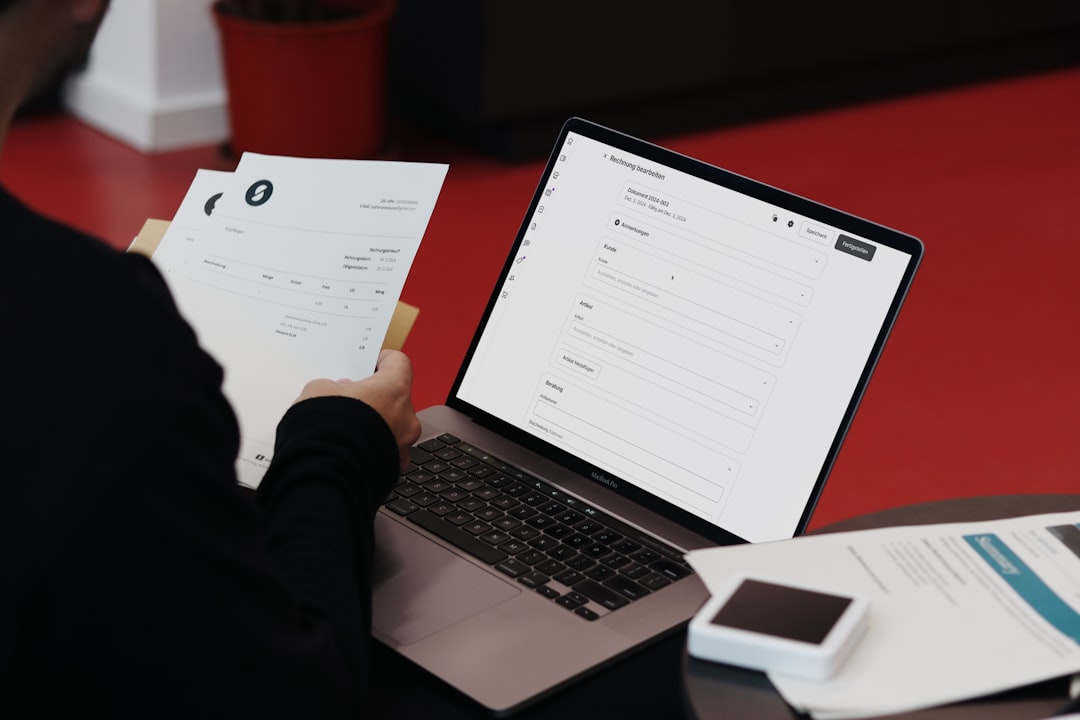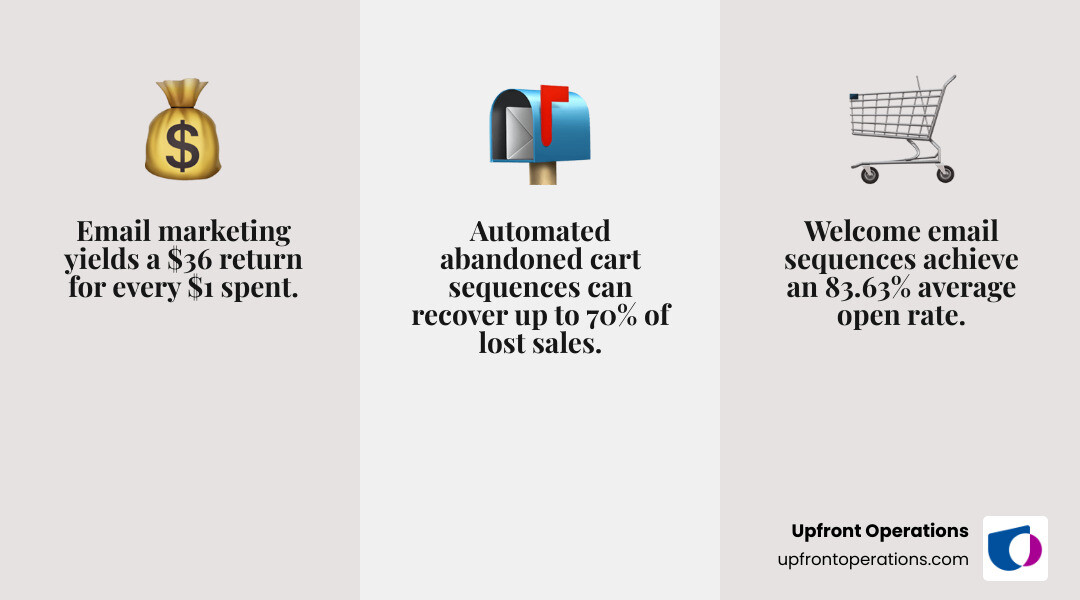Automated Email Sequences Made Easy—No Tech Wizardry Required
Create automated email sequences easily. Boost sales, nurture leads & save time with our step-by-step guide. No tech wizar...
Create automated email sequences easily. Boost sales, nurture leads & save time with our step-by-step guide. No tech wizar...

An automated email sequence is a series of pre-written emails sent to subscribers based on specific triggers, like signing up for a newsletter or abandoning a cart. Here's a quick overview:
Key Components:
Main Benefits:
Tired of manually sending follow-ups and watching hot leads slip away? Email automation is the solution. Automated sequences work 24/7 to nurture relationships and drive sales, handling the heavy lifting so you can focus on running your business.
I'm Ryan T. Murphy, and over the past 12 years, I've helped 32 companies implement automated email sequence strategies that cut sales cycles by up to 28% and open up millions in new revenue. At Upfront Operations, we specialize in turning complex marketing automation into simple, profitable systems that work while you sleep.

An automated email sequence is like a personal marketing assistant that sends a series of carefully crafted emails to subscribers based on what they do—or don't do. Actions like signing up for a newsletter or abandoning a cart become triggers that kick off a personalized email journey.
What makes this so powerful is that sequences respond intelligently to each person's actions, or subscriber behavior. This level of personalization creates genuine connections and allows for scalability, nurturing thousands of leads with the same care you'd give a handful.
While often used interchangeably, an automated sequence is different from a "drip campaign."
| Feature | Automated Email Sequence | Drip Campaign |
|---|---|---|
| Nature | Dynamic, Behavior-Based - Adapts to subscriber actions | Static, Time-Based - Sends on a fixed schedule |
| Trigger Logic | Multiple triggers (clicks, purchases, page visits) | Single trigger (usually a sign-up) |
| Flexibility | Highly flexible - sequence changes based on actions | Less flexible - everyone gets the same emails |
| Personalization | Deeply personalized with behavioral data | Basic personalization (e.g., first name) |
| Purpose | Nurturing, onboarding, conversion, relationship building | Information delivery, announcements |
Think of it this way: A drip campaign is like a scheduled TV show. An automated email sequence is like Netflix—it recommends what to watch next based on what you've already enjoyed.
Automated email sequences deliver an impressive $36 for every $1 spent, making email marketing one of the highest ROI channels available. The benefits go beyond just money:
Building a successful sequence requires a solid foundation:
Think of automated email sequences as your digital sales team that never sleeps. After helping 32 companies implement these systems, I've seen which sequences truly move the needle. These seven types are the foundation of a successful email marketing strategy, turning casual browsers into loyal customers.
Your welcome sequence is your crucial first impression. It boasts an incredible 83.63% average open rate, so this is your prime window to build trust. The key is to deliver immediate value, whether it's a free guide, a discount, or a warm introduction. A great welcome sequence establishes your brand personality and answers the subscriber's question: "What happens next?"
An onboarding sequence ensures new customers succeed with your product or service, turning them into long-term advocates. This is vital for SaaS, online courses, or any business where customers need to learn something new. Focus on quick wins by guiding users through the most important first steps. Include step-by-step guides, video tutorials, and success stories to help them reach that "aha moment" quickly. We can help you Set up HubSpot to Drive Sales with automations that keep new customers engaged.
Not everyone is ready to buy immediately. A lead nurturing sequence builds relationships over time by educating prospects and positioning your business as the obvious choice. This is powerful for longer sales cycles. Focus on education over selling by sharing case studies, industry insights, and answers to common questions. The goal is to stay top-of-mind without being pushy. Learn more about our approach to Automated Lead Nurturing and crafting a winning Lead Nurturing Email Strategy.
With 70% of shoppers abandoning their carts, this sequence is pure gold for e-commerce. Abandoned cart emails have a 39.07% open rate, and retailers can recover up to 63% of lost revenue. Timing is everything: send the first reminder within an hour. Follow up with emails that address potential hesitations, like including customer reviews or offering free shipping.
This sequence wins back dormant contacts before they're lost forever, which is five times cheaper than acquiring new customers. It also helps clean your email list for better deliverability. Start with a "we miss you" message, remind them of the value you offer, and consider giving them control with options to update preferences or unsubscribe. Our expertise in Nurture Campaigns can help you revive dormant contacts.
Your existing customers are your most valuable asset, with a 60-70% likelihood to buy again. This sequence maximizes that opportunity by recommending products that complement a previous purchase. The secret is to be helpful, not pushy. Focus on the additional value the new product provides. We can help you Set up Automated Follow Ups that intelligently recommend products and grow revenue automatically.
For webinars, workshops, or product launches, an event sequence manages all communication to maximize attendance and engagement. It includes invitations, reminders, and post-event follow-ups with recordings or resources. Post-event follow-up is crucial; include thank you messages and clear next steps. This is a key part of streamlining your Sales Process Automation.
Creating a high-converting automated email sequence isn't rocket science. With the right roadmap, you can build profit-generating machines. Here is our proven six-step process.
Before writing, get clear on why you're sending emails and who you're talking to. Set SMART goals (e.g., "recover 15% of abandoned carts") to guide your decisions. Then, dive deep into your buyer personas to understand their pain points and motivations. Use segmentation to group your audience by behavior or interests, ensuring your messages are always relevant. Our guide on Lead Nurturing Definition can help you identify your audience.
Design your customer's journey. Decide on the number of emails (typically 3-5 for a welcome series, 7-10 for nurturing) and the timing between them. An abandoned cart reminder might go out in an hour, while a B2B nurturing email might wait 2-3 days. Map out your triggers (what starts the sequence) and conditions (what stops it, like a purchase). A simple flowchart can help visualize the entire journey. If this sounds complex, our on-demand service to Create Basic Email Automation can handle it for you.
This is where you create a human connection.
Stuck on what to write? Use AI tools like ChatGPT as your creative co-pilot. With 43% of email marketers using AI, it's a proven way to brainstorm ideas, generate drafts, and refine copy. Provide detailed prompts about your goal, audience, and tone. AI is a powerful assistant, but always review and edit its output to inject your unique brand personality and empathy.
Bring your blueprint to life using marketing automation software like HubSpot, Mailchimp, or ActiveCampaign. Most platforms use a drag-and-drop interface. Set up your triggers to enroll contacts, then add your emails and delays. Crucially, configure exit conditions to unenroll contacts when they make a purchase or take another key action. If you're overwhelmed by the tech, our service to Streamline HubSpot Operations can handle the entire setup.
Launching your sequence is the starting line, not the finish. Before going live, test everything—links, formatting, personalization, and logic. Once live, monitor your key metrics: open rates, click-through rates (CTR), and conversion rates. Use A/B testing to experiment with subject lines, content, and CTAs. Use this data to continuously improve your sequence. For more optimization strategies, see our guide on Automated Email Marketing Campaigns.
There's no magic number. Most effective sequences are 3 to 8 emails long, but the length should match your goal and sales cycle. A simple welcome sequence might be 3-5 emails, while a complex B2B lead nurturing sequence could be 8-10 emails sent over several weeks. The rule of thumb: keep sending emails as long as you're providing value and your audience is engaged.
We've seen the same avoidable mistakes pop up again and again. Be sure to avoid:
Absolutely. Modern marketing platforms like HubSpot and Mailchimp have made creating an automated email sequence accessible with user-friendly, drag-and-drop interfaces and pre-built templates. You can build a sequence without writing any code.
However, learning a new platform and managing all the details can still be time-consuming. That's why we offer on-demand microservices. Instead of spending weeks on setup, you can use our Create Automated Lead Nurturing service to get a professionally built sequence without the learning curve. We handle the technical work so you can focus on your business.
We've covered why automated email sequences are essential, the must-have types for your business, and how to build them step-by-step. The takeaway is clear: these sequences are vital for efficient growth.
They work 24/7 to build relationships, drive sales, and save you invaluable time by handling repetitive follow-ups. While you focus on strategy, your sequences are nurturing leads, onboarding customers, and recovering lost sales.
At Upfront Operations, we believe powerful marketing automation should be accessible to everyone. We deliver essential and simple microservices on-demand, giving you exactly what you need, when you need it. Whether you're a small business that needs someone to Automate Email Marketing or a larger company needing elite fractional sales operations, we can help.
We surpass traditional agencies and freelancers by providing targeted expertise without the overhead. No long contracts, just the specific help you need to get your automated email sequences working for your business.
Ready to let automation handle the heavy lifting? We're here to make it happen.